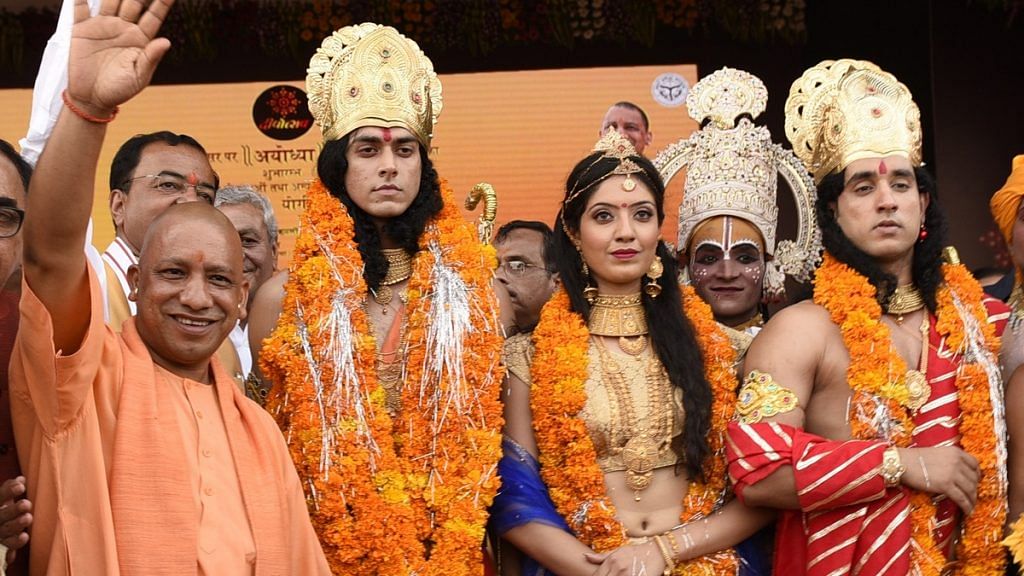Hindutva can’t be the main narrative of the BJP for 2019 – and if it is, will backfire.
A week is a long time in politics, five months is eternity. The consensus that we are headed for a Narendra Modi-led coalition in 2019 could well change over the next few months. Come 11 December, a high-pitched national campaign will carpet-bomb our collective consciousness. But what will Modi sell this time?
Modi did very little of Hindutva in 2014, though his party did enough of it, especially in western Uttar Pradesh. Modi was already the ‘Hindu Hriday Samrat’, the ‘Emperor of Hindu Hearts’, so he posited himself as the ‘Vikas Purush’, or the Development Man, to get the extra votes.
20% is not a majority
Given how Modi’s Vikas narrative has fizzled out, what could be his big pitch? In 2014, it was Emperor Hindutva selling Vikas. Could it be the reverse in 2019 – Vikas taking a backseat and Hindutva being the central narrative? The coordinated noises about an ordinance to bypass the Supreme Court and create a Ram Mandir in Ayodhya would suggest the BJP is back to Hindutva for 2019.
It is to be noted, however, that Modi is still insulating himself from such high-pitched noises. Over the past 4.5 years, he has strategically taken to making Hindutva comments just before state elections. Barring that exception, he largely sticks to Hindu symbolism rather than anti-minority rhetoric.
Modi has outsourced that job to Yogi Adityanath by making him the Uttar Pradesh chief minister. Yogi Adityanath goes to any state where elections are being held to act as a Hindutva stand-in, assuring the BJP’s core constituency that the party is not abandoning its ideological commitments.
That itself tells you how the BJP sees Hindutva: it can never make the party win an election by itself, not even in the Hindutva laboratory of Gujarat. At most 20 per cent of the electorate votes on account of Hindutva, if you go by the fact that 18-20 per cent is the BJP’s minimum vote share in Lok Sabha elections.
Also read: What we’re seeing under Narendra Modi is Hindutva 2.0
Khas aadmi ko kya mila?
This 20 per cent is mostly upper caste and well to do. And these days, they are unenthused with the BJP. They are crying for the party’s attention, almost like an election-eve blackmail. What has Modi done, they ask, in terms of economy or Hindutva?
While liberals complain about cow vigilante lynchings, the BJP’s core voter feels Modi hasn’t been Hindutva enough. Besides, the party has been ignoring the upper caste to broad-base itself among the OBCs and even Dalits. You see this reflected in the anger over the SC/ST Act. This is a reflection of the sentiment that Modi isn’t letting upper caste Hindu voters feel like they’re in power, and it’s their own government.
In other words, the BJP and even PM Modi will have to resort to some amount of Hindutva positioning to keep their core voters in good spirits.
Also read: Why liberals are afraid to admit there’s more to Modi than just Hindutva
Saffron is not salt
That is not to say the BJP wants to dump Hindutva and is forced to sing its tune. On the contrary, the BJP knows the limits of electoral Hindutva. If Hindutva becomes Modi’s central narrative, it is likely to backfire. It will be like an admission before swing voters that Vikas has failed.
The word on the street is that the BJP will resort to fomenting riots to win elections, now that Modi’s grand Achhe Din promises have fizzled out. If the BJP and Modi do what people already expect from them, they would only confirm having run out of Vikas to sell. Saffron is good, but it can’t replace salt on the aam aadmi’s table.
This is why the BJP’s 2019 campaign is likely to have a lot of Hindutva but it won’t overtake Modi’s central narrative, whatever that may be. We are likely to continue seeing provocative Hindutva messaging in political discourse – from Assam’s NRC to triple talaq to renaming cities to Ram Mandir.
Hopefully, it will remain all bark and no bite. If the BJP-RSS are accused of fresh blood on their hands, it will feed into the idea that the BJP is resorting to communal violence since Vikas has failed. A lot of middle-of-the-road centre-right Hindu voters don’t mind Hindutva, have no love lost for secularism, but don’t condone violence either. Saffron is good, but not when it transforms into red chilli powder. This is also why Hindutva forces take to violence mostly when the BJP is not in power.
Also read: Why Rahul Gandhi will fall off the tightrope between Hindu and Hindutva
Statue is the new temple
Raising the pitch on Ram Mandir these days may help divert attention from Rafale, CBI, RBI and so on, but the noise is likely to be short-lived. An ordinance is not legally feasible, and talk about it is just a red rag for the opposition and the media. Or rather, a red herring.
The Ram Mandir issue as a point of polarisation is anyway a used bullet. It cannot achieve the same polarisation it did in 1992. The public always demands newer distractions to obsess over, not some old whine in a new bottle. Yogi Adityanath’s announcement of a gigantic statue of Lord Ram in Ayodhya will be sold as a closure to the Ram Mandir issue to the core supporters, at least for this election cycle.
